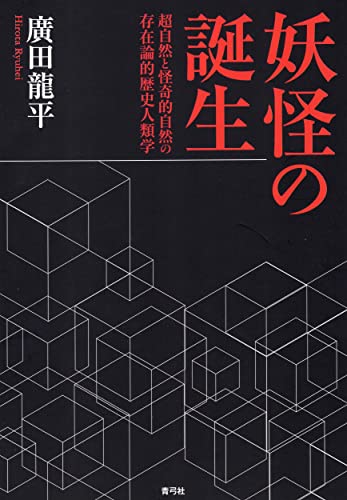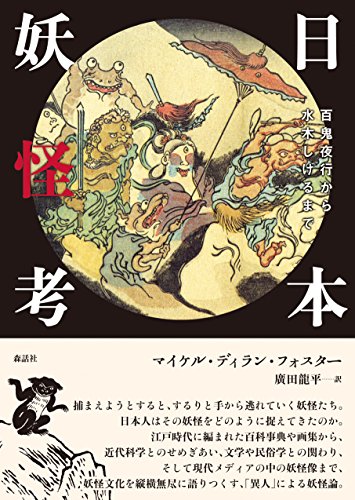79 0 0 0 OA <研究論文>シャーマン=狩人としての動物 : 世間話における妖狐譚を構造分析する
- 著者
- 廣田 龍平
- 出版者
- 国際日本文化研究センター
- 雑誌
- 日本研究 = NIHON KENKYŪ (ISSN:24343110)
- 巻号頁・発行日
- vol.63, pp.85-111, 2021-10-29
本稿は、キツネをめぐる世間話を題材として、アニミズムおよびパースペクティヴィズム理論を参照することにより、日本におけるヒトと動物の関係性の根底にある諸存在論を明らかにすることを目的とする。キツネが人間に変身したり(「化ける」)、ヒトの知覚を操作したりする(「化かす」)妖狐譚は、日本における非西洋近代的な存在論を明らかにするにあたって重要な資料になると考えられる。しかしこれまでは、ほとんど総合的な議論がなされてこなかった。それに対して本稿では、「変身」概念を中核に据えるアニミズムおよびパースペクティヴィズム理論を採用することにより、それらの理論が依拠する北アジア・南北アメリカの狩猟アニミズム世界とキツネの妖力を構造的に比較できることを示す。アニミズムにおいては、ヒトも動物も同じような霊魂を持ち、同じような文化を持つが、身体が異なる。そのため身体を変えることにより、ヒトが動物に、動物がヒトに変身することが可能になる。またパースペクティヴィズムは、身体に由来する観点の差異化により、種によって知覚される世界が異なってくることを前提とする。これらの枠組みを採用することにより、妖狐譚がうまく理解できるようになる。 本稿の中心的関心は、妖狐譚に見られるヒトと動物の関係性が、狩猟アニミズムと比較すると、構造的に反転しているという点である。狩猟アニミズムにおいてはヒトが「衣服」を身に着けて動物に変身するのに対し、妖狐譚においてはキツネが髑髏や藻などを身に着けて人間に変身する。また、狩猟アニミズムにおいてはヒトのシャーマンや精霊が、それぞれ動物や通常のヒトの観点を操作するのに対して、妖狐譚においては、キツネがヒトの観点を操作する。こうしたことから、日本のキツネは狩猟アニミズム世界におけるヒトのシャーマンや狩人の対称的反転であり、それが日本的な存在論の特徴であることが結論付けられる。
52 0 0 0 俗信、科学知識、そして俗説 : カマイタチ真空説にみる否定論の伝統
- 著者
- 廣田 龍平
- 出版者
- 日本民俗学会
- 雑誌
- 日本民俗学 = Bulletin of the Folklore Society of Japan (ISSN:04288653)
- 巻号頁・発行日
- no.287, pp.1-35, 2016-08
39 0 0 0 OA 異人論が異人と出あうとき 動物=妖怪としての異人をアマゾニアに探る
- 著者
- 廣田 龍平
- 出版者
- 物語研究会
- 雑誌
- 物語研究 (ISSN:13481622)
- 巻号頁・発行日
- vol.22, pp.215-229, 2022-03-31 (Released:2023-04-01)
35 0 0 0 OA 存在論的反転としての股のぞき
- 著者
- 廣田 龍平
- 出版者
- 一般社団法人 日本民俗学会
- 雑誌
- 日本民俗学 (ISSN:04288653)
- 巻号頁・発行日
- vol.308, pp.39-55, 2021-11-30 (Released:2023-08-02)
- 参考文献数
- 76
This article examines the ontological function of a body technique called matanozoki, which is found sporadically in the Japanese archipelago in modern times. Matanozoki is a posture of bending oneʼs body and looking backward from between the legs, corresponding to what is labeled in the Motif-Index of Folk-Literature as D1821.3.3.: “magic sight by looking under oneʼs legs.” This article also takes another magical posture called sodenozoki (D1821.3.1., “magic sight by looking under arm”) as having the same ontological function since there is structural isomorphism with matanozoki. Through matanozoki or sodenozoki, one can discover that ships or human beings could actually be a host of ghosts of the drowned or mysterious foxes or other yōkai (mysterious nonhuman beings), or that yōkai that trying to hide their actual bodies with magic could be there. Furthermore, there is a modern folk belief that an infant doing matanozoki is a sign of its motherʼs pregnancy, indicating that matanozoki enables infants to see the near future. Quite similar beliefs that demons and future spouses can be glimpsed between the legs can also be found in Europe, Asia, the Americas, and Africa. Tsunemitsu Toru claims that what one sees by matanozoki is the other world. However, a closer look at the cases collected by Tsunemitsu and others shows that in some cases, matanozoki enables a person to restore his/her normal sight. These cases imply that the person involved had already been transformed into an abnormal being by mischievous yōkai with their mysterious power. Adopting the anthropological theory of perspectivism, this article proposes a hypothesis that many peoples consider matanozoki (D1821.3.3.) as a switch between normal human sight and mysterious nonhuman sight. Assuming that matanozoki reverses the ontological relationship between the world and the human body, this hypothesis can possibly provide a consistent explanation to various cases of matanozoki, including similar cases in other countries.
27 0 0 0 有形と無形の人類学:「妖怪的なもの」の概念的把握に向けて
- 著者
- 廣田 龍平
- 出版者
- 日本文化人類学会
- 雑誌
- 日本文化人類学会研究大会発表要旨集 (ISSN:21897964)
- 巻号頁・発行日
- vol.2016, 2016
本分科会では、日本の「妖怪」概念の再検討を出発点として、前近代的な民間伝承から最先端の科学技術までを事例として取り扱い、フィールドにおける「有形と無形のあいだ」のものと人々とが織りなす関係性にアプローチすることを試みる。これは調査者の世界とフィールドの世界の二分法を問い直す一つの試みである。
- 著者
- 廣田 龍平
- 出版者
- 日本文化人類学会
- 雑誌
- 日本文化人類学会研究大会発表要旨集 (ISSN:21897964)
- 巻号頁・発行日
- vol.2016, 2016
本発表は、日本の「妖怪」を人類学的に把握することを通じて、「無形と有形のあいだ」に現われるフィールドの諸対象を位置づける概念として提示するものである。事例として用いるのは、柳田國男が昭和初期に著した「妖怪名彙」に現われる妖怪、そしてネット怪談として知られる「くねくね」という妖怪の二つである。
17 0 0 0 IR 妖怪の存在論的歴史人類学 : 日本における妖怪研究の概念および学史の批判的再構築
- 著者
- 廣田 龍平 ヒロタ リュウヘイ HIROTA Ryuhei
- 出版者
- 筑波大学 (University of Tsukuba)
- 巻号頁・発行日
- 2021
【要旨】
11 0 0 0 OA 神なき時代の妖怪学
- 著者
- 廣田 龍平 Ryuhei HIROTA
- 出版者
- 現代民俗学会
- 雑誌
- 現代民俗学研究 = Journal of Living Folklore (ISSN:18839134)
- 巻号頁・発行日
- vol.9, pp.43-53, 2017-03
Despite the popular assumption that yōkai has been one of the central themes in Japanese folkloristics, there have actually been few monographs about them. Given this, I discuss how yōkai became excluded from folkloristics by examining works of Kazuhiko Komatsu. By contrasting Komatsu and Kunio Yanagita, I suggest that Komatsu more or less explicitly replaced yōkai from old-style folkloristics to structural anthropology. His analysis of yōkai is particularly anthropological in that he takes them to be found in the world of the Other. This fact contrasts sharply with his (and Yanagita’s) definition of folkloristics as an understanding of the Self. Yet another of his definitions would explain this replacement: a central theme of folkloristics is“ kami.” Examination of his works reveals that his view on yōkai implies that while his formulation of the continuity between yōkai and kami could apply to folk societies of the Other, contemporary societies lost this continuity. Therefore yōkai became excluded from his folkloristics.
8 0 0 0 IR スクリーンの向こうの「異世界」
- 著者
- 廣田 龍平 ヒロタ リュウヘイ HIROTA Ryuuhei
- 出版者
- 東京外国語大学アジア・アフリカ言語文化研究所
- 雑誌
- Field+ : フィールドプラス : 世界を感応する雑誌 / 東京外国語大学アジア・アフリカ言語文化研究所 [編] (ISSN:18834957)
- 巻号頁・発行日
- no.26, pp.18-19, 2021-07-10
8 0 0 0 OA 妖怪の、一つではない複数の存在論 ―妖怪研究における存在論的前提についての批判的検討―
- 著者
- 廣田 龍平
- 出版者
- 現代民俗学会
- 雑誌
- 現代民俗学研究 = Journal of Living Folklore (ISSN:18839134)
- 巻号頁・発行日
- no.6, pp.113-128, 2014-03
This article critically examines the ontological commitment on which modern folkloristic studies of yokai (a category of mysterious creatures in Japanese tradition) have been established. Academic yokai scholars have assumed that yokai are supernatural beings and that yokai do not exist in mundane form. However, the adequacy of these assumptions when studying the world of people who does not share the same ontological framework as modern scholars has hitherto been of little concern in yokai studies. Through critically examining the discourses and theories that have dominated yokai studies, this article suggests that researchers have failed to understand the perspective of folk who recognize and co-inhabited with yokai.Why have yokai studies assumed this ontological commitment? There is a historical process continuing from the late Edo period on in which intellectuals and urbanites increasingly assumed what is now called yokai to be supernatural and unreal. At the turn of nineteenth century, some scholars who sought to affirm the reality of yokai began to juxtapose the supernatural realm against the backdrop of the rise of modern scientific empiricism in Japan. Furthermore, the presumed supernatural essence of yokai was a perspective that had also slowly been adopted by disbelieving researchers. This article conceives this process as an epistemological rupture by which researchers can only understand different worlds or ontologies through the ontological framework generated after the rupture. This article proposes a "plural ontology" model that makes it possible for researchers to understand the diverse worlds in which people recognize yokai.
- 著者
- 廣田 龍平
- 出版者
- 青土社
- 雑誌
- ユリイカ (ISSN:13425641)
- 巻号頁・発行日
- vol.52, no.15, pp.319-326, 2020-12
- 著者
- 廣田 龍平
- 出版者
- 白帝社
- 雑誌
- 口承文藝研究 = Studies in folk-narrative (ISSN:24362263)
- 巻号頁・発行日
- no.41, pp.104-116, 2018
4 0 0 0 存在論的反転としての股のぞき
- 著者
- 廣田 龍平
- 出版者
- 日本民俗学会
- 雑誌
- 日本民俗学 = Bulletin of the Folklore Society of Japan (ISSN:04288653)
- 巻号頁・発行日
- no.308, pp.39-55, 2021-11
3 0 0 0 カッパはポセイドンである : 近世後期における東西妖怪比較試論
- 著者
- 廣田 龍平
- 出版者
- 世間話研究会
- 雑誌
- 世間話研究 (ISSN:13415646)
- 巻号頁・発行日
- no.24, pp.20-66, 2016-05
2 0 0 0 OA 「妖怪」概念の人類学的再検討 有形と無形のあわいに存する民俗的対象について
- 著者
- 廣田 龍平
- 出版者
- 日本文化人類学会
- 雑誌
- 日本文化人類学会研究大会発表要旨集 日本文化人類学会第50回研究大会 (ISSN:21897964)
- 巻号頁・発行日
- pp.D12, 2016 (Released:2016-04-23)
本発表は、日本の「妖怪」を人類学的に把握することを通じて、「無形と有形のあいだ」に現われるフィールドの諸対象を位置づける概念として提示するものである。事例として用いるのは、柳田國男が昭和初期に著した「妖怪名彙」に現われる妖怪、そしてネット怪談として知られる「くねくね」という妖怪の二つである。
1 0 0 0 妖怪の誕生 : 超自然と怪奇的自然の存在論的歴史人類学
1 0 0 0 日本妖怪考 : 百鬼夜行から水木しげるまで
- 著者
- マイケル・ディラン・フォスター著 廣田龍平訳
- 出版者
- 森話社
- 巻号頁・発行日
- 2017
1 0 0 0 神なき時代の妖怪学
- 著者
- 廣田 龍平
- 出版者
- 現代民俗学会
- 雑誌
- 現代民俗学研究 (ISSN:18839134)
- 巻号頁・発行日
- no.9, pp.43-53, 2017
1 0 0 0 IR 神なき時代の妖怪学
- 著者
- 廣田 龍平 Ryuhei HIROTA
- 出版者
- 現代民俗学会
- 雑誌
- 現代民俗学研究 (ISSN:18839134)
- 巻号頁・発行日
- no.9, pp.43-53, 2017
Despite the popular assumption that yōkai has been one of the central themes in Japanese folkloristics, there have actually been few monographs about them. Given this, I discuss how yōkai became excluded from folkloristics by examining works of Kazuhiko Komatsu. By contrasting Komatsu and Kunio Yanagita, I suggest that Komatsu more or less explicitly replaced yōkai from old-style folkloristics to structural anthropology. His analysis of yōkai is particularly anthropological in that he takes them to be found in the world of the Other. This fact contrasts sharply with his (and Yanagita's) definition of folkloristics as an understanding of the Self. Yet another of his definitions would explain this replacement: a central theme of folkloristics is" kami." Examination of his works reveals that his view on yōkai implies that while his formulation of the continuity between yōkai and kami could apply to folk societies of the Other, contemporary societies lost this continuity. Therefore yōkai became excluded from his folkloristics.



